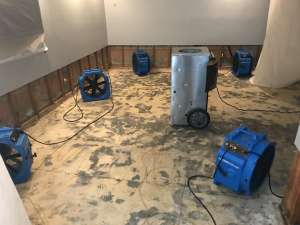Air Duct Cleaning
What is Water damage, and its causes?

What is Water damage, and its causes?
Water damage is the most common and costly problem faced by homeowners. It can occur anytime, anywhere in the home – from a faulty appliance or plumbing to heavy rains and flooding.
So what could you do to prevent water damage? The first step is to act fast. The longer water stays, the more damage it will cause. So if you have any standing water, be sure to remove it as soon as possible. Next, dry out the affected area thoroughly. This may require bringing fans or dehumidifiers to help speed up the process.
The Initial signs of water damage
One of the first signs of water damage is usually a musty smell. The reason is mold and mildew growing in damp areas. If you notice this smell, check for any visible signs of water damage, such as stains on walls or ceilings.
Another sign of water damage is peeling paint or wallpaper resulting from moisture seeping behind the walls. If you see this, it’s essential to check for any hidden leaks.
Warping or cupping may be a sign of water damage if you have hardwood floors. It happens when moisture seeps into the wood and causes it to swell.
What is the biggest concern with water damage?
The biggest concern with water damage is the potential for mold and mildew growth. We all know that mold thrives in wet environments and causes serious health problems, such as respiratory infections and allergic reactions. If not treated quickly and adequately, it spreads throughout the home, causing even more damage.
Another worrisome concern with water damage is the structural damage it can cause to your home. Water can weaken beams and supports, making them more likely to collapse. It can also cause paint to peel and wallpaper to blister.
The restoration process: what to expect
The water restoration process takes weeks or even months, depending on the severity of the damage. Here’s what you can expect during the restoration process:
- First, a professional assesses the damage and then develops a repair plan. 2. Next, they will repair any structural damage and replace any damaged materials.
- Once the repairs are complete, they usually focus on the cosmetic work, which may include painting, flooring, and other finishes.
- The last step is to thoroughly clean the space to remove any debris or odors from the repairs.
Undoubtedly, the restoration process is long and complex, but Knowing what to expect throughout the process will help make the process less complicated. If you have any questions, be sure to talk to your restoration professional so they can put your mind at ease.
Conclusion:
In conclusion, the water damage restoration process could be lengthy, but it’s completely worth it. But please remember to take your time, be patient, and choose the right professional to do the restoration task.
EzGreen is a leading water damage restoration company. We’re available 24/7 to help you in any emergency. Contact us now to get a free estimate from our top-rated water damage restoration company!
FAQ
What should I do immediately after water damage?
If you have water damage, you should first call a professional to assess the situation. Water damage can be tricky to deal with, but if you handle it correctly, you can easily avoid further damage. Once you’ve called a professional, they can help you take care of the next steps.
How do you prevent water damage?
Here are a few essential points that you consider to avoid water damage: -Make sure your gutters are clean and in good repair, so they can properly drain water away from your home.
-Regularly inspect your roof for signs of leakage or damage.
-If you have a basement, make sure it is well-insulated and has a waterproofing sealant to keep moisture out.
How long does water damage take to dry out?
The amount of time it takes depends on the extent of the damage, the type of materials affected, and the weather conditions.
How much does it cost to treat water damage?
It depends on the extent of the water damage. If it’s just a little bit of water, it may only take a day or two for everything to dry out. But if the water damage is more extensive, you can expect to take weeks or even months to dry out completely.
What happens if water gets behind the siding?
If water gets behind your siding, it can cause many problems. It can rot the wood, cause mold and mildew to grow, and damage your home’s structure. So remember to seal any gaps and siding correctly.
Book your service
Please leave us your details, and we will get back to you ASAP
